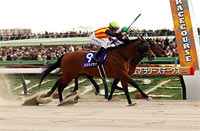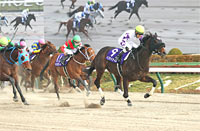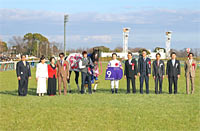2015 News
Data Analysis for the "2015 February Stakes (G1)"The race to become the spring dirt champion! Held on the 1,600m dirt course at Tokyo, the February Stakes is regarded as the dirt champion decider for the spring racing season. Last year, 16th favorite Copano Rickey held off a challenge from Hokko Tarumae to record his first G1 win, but what dramas await us this year? To answer that, let’s dig out some trends shared by successful horses from results over the last 10 years. Dominance of 4- and 5-year-olds First, a look at the performance by age over the last 10 years shows that all ten winners have been “4- to 6-year-olds.” In particular, “4-year-olds” and “5-year-olds” are one step ahead of the others in both the win ratio and the top 2 ratio. Horses aged “7 and up” have produced four runners-up and should not be overlooked, but the dominance of younger horses is beyond doubt. [Table 1] [Table 1] Performance by age (last 10 years)
Better showing from outside numbers Turning next to the performance by horse number over the last 10 years, two winners in that time had numbers “1-5” and eight had “12-16”; the middle numbers have not produced a single winner. In terms of success ratios (other than the win ratio), the figures get better the closer the horse is to the outside numbers. In particular, horses with numbers “12-16” have been markedly successful, monopolizing the first two places in 2009, 2011 and 2014. [Table 2] [Table 2] Performance by horse number (last 10 years)
Look for a top 3 finishers last time out Next, to aggregate performances by the runners’ finish in their previous race, nine of the ten winners had finished “in the top 3” last time out. Moreover, 19 of the 20 top two finishers had been placed “in the top 5” in their previous outing. The only top two finisher with a placing of “6th or lower” last time out was 2014 winner Copano Rickey (9th in his previous outing). In this race, we should keep a lookout for horses that finished among the leading places in their most recent outing. [Table 3] [Table 3] Performance by finish in previous race (last 10 years)
Distance in last 3 races is important Now let’s focus on the distance of the previous three races contested by runners over the last 10 years. Here, horses that have contested “2 or more” dirt races over 1,800m or more within their last three outings have far better success ratios than those appearing “no more than once” in such races. Horses mainly contesting middle-distance races in their recent outings would appear to have the edge over those mainly running distances of a mile or less. [Table 4] [Table 4] Performance by number of starts in 1,800m+ dirt races in the last three outings (last 10 years)
Seek out the winners! –Check last October’s race record A look at the past race record of February Stakes winners shows that five of the seven winners since 2008 had not contested a race in October of the previous year, while the other two had won a race in that month. Although big races (principal dirt races) are held at NAR racecourses every October, it might be interesting, this year too, to check for horses that did not run in those races but were held in reserve for November onwards – or else won a race in the previous October. [Table 5] [Table 5] Winners' race record in the previous October (last 7 years)
(Data analysis by Michio Kawano) |
|



















